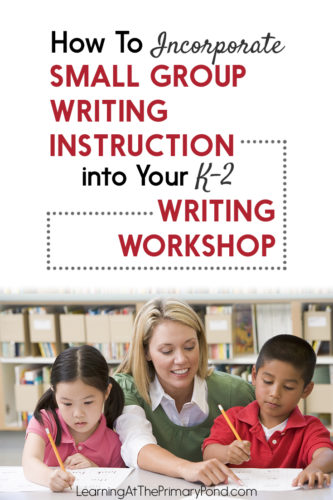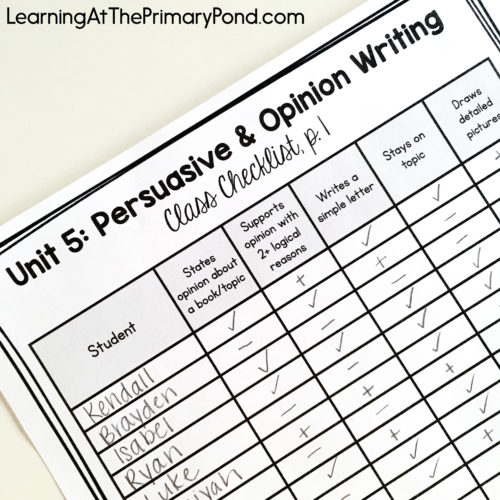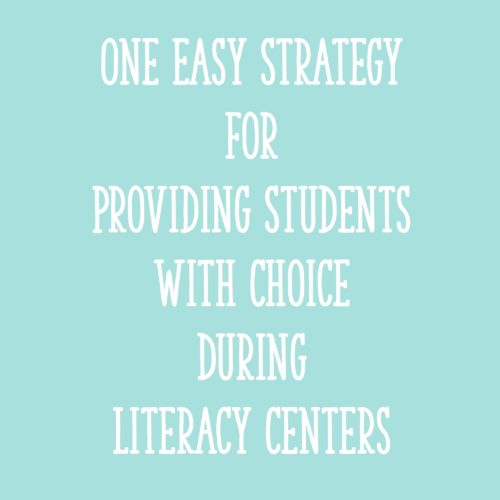In my most recent post, I explained how much I love individual writing conferences. I also gave an in-depth explanation of how I conduct them.
Although individual conferences are a great way to differentiate your writing instruction, small group instruction is just as important! When I meet with small groups, I can reach a greater number of students (yay for efficiency!) and still provide them with more individualized instruction than I can during my whole group minilessons.
So in today’s post, I’m sharing the who, what, when, where, why, and how of small group writing instruction!
Photo Credit: Monkey Business Images, Shutterstock
Why?
Yeah, I know, I was supposed to begin with “Who?” 🙂 But before I get into all of the details, I think it’s important to consider the why.
I begin each writing workshop period with a whole class minilesson. In my minilessons, I cover the essential strategies students need to learn in order to successfully write pieces in our current genre of study. I have an outline for the minilessons before I begin a unit, but I also adjust the minilessons to meet students’ needs.
When I choose topics for the minilessons, I generally “teach up.” I want to expose my students to grade-level AND more advanced strategies. I definitely address students’ needs, but I also want to challenge them and expose them to examples of excellent writing.
Of course, not all of my kids are able to apply those strategies to their writing. So I need to a) address their current areas of weakness and b) provide supports to help them implement the strategies I suggest in the minilessons. Both of these things can take place in a small group setting. (They can also happen during conferences, but we can reach more children quickly when we pull them together in small groups.)
On the other hand, some of my kids can quickly and easily implement the strategies I introduce in whole group minilessons. These kids may need to a) get help filling in gaps here and there, and b) be challenged to apply the strategies in more sophisticated ways. I can do both of these things in a small group setting.
Who?
A small group writing conference involves you and 2-5 students. In my opinion, the “sweet spot” is around 3 or 4 kids (and I like to stick to 3 for Kindergarten or early first grade).
The students don’t necessarily have to have similar overall skill levels as writers. But they need to have a similar area of need or a similar area where they would benefit from a challenge. Here are some examples:
- Need to use the word wall more consistently
- Need to add more details to their writing
- Need to use capital letters only at the beginning of sentences
- Need to stick to facts, rather than opinions, in their “all about” books
- Could benefit from learning how to add dialogue to their stories
- Could benefit from learning to write more engaging introductions
- Could benefit from learning to add adverbs to their stories
At the beginning of writing time, take a few minutes to do some “drive-by” observations. Based upon what you notice, you may be able to pull together a small group to address a significant need before you move on to individual conferences.
Checklists are also a great way to discover which students can be grouped together for small group instruction. The checklist below, from one of my writing units, can be used to track students’ progress toward the goals of the unit. You can fill out the checklist as you confer with students and/or as you review their writing on your own. As you notice patterns, you can pull groups of students together to meet their needs, fill in gaps, and challenge them.

Here’s another idea – if you feel that some of your students are up to the challenge, have a student or pair of students teach a writing small group!
Of course, a student-led small group won’t be quite the same as if you were teaching it. You might structure it so that a student-leader shares his/her writing and talks about why he/she made a particular choice as a writer. The leader then helps the other students try out the strategy in their own writing. (Example: One student decided to use onomatopoeia (sound words) in her writing. She shows the other students what she did and then helps them brainstorm sound words to add to their own stories.)
What?
Next week, I’ll be going more in-depth on what I teach during my small group writing instruction. For now, here are some tips for deciding what to teach during your small groups:
- Choose a SINGLE focus for each group!
- Keep your unit goals in mind.
- Remember that you can (and should) teach a strategy more than once! You may need to meet with the same small group a few different times before they begin applying a strategy independently. Change things up by sharing a mentor text during one small group, doing some shared writing the next time, and so on.
Check back next week for more information about what to teach during your small groups (and individual writing conferences)!
Where?
My small group writing conferences usually take place at my small group table. I call students’ names (we don’t have set groups), and they bring their writing folders and a writing utensil.
In her book Small-Group Writing Conferences, Holly Slaughter discusses table conferences. In a table conference, you come to a group of kids who are already sitting together, rather than having them come to you.
You might choose to conduct a table conference if you notice that all of or most of the students in a table group need help with a particular strategy. This is a great way to quickly meet students’ needs – and having them “stay put” saves time, too.
When I taught Kindergarten, my students sometimes needed a little extra reinforcement of the strategy I’d taught in the day’s minilesson. I conducted my own version of table conferences by quickly checking in with a few tables and reminding them about the strategy. If one or two students at the table were applying it successfully, I praised them and pointed it out to the other students at the table.
When?
My goal is to teach one small group writing conference each day, during independent writing time. Sometimes I can fit in two, but I normally use the remaining time for individual conferences and check-ins.
One small group usually lasts about 10 minutes. My table conferences only last about 5 minutes, so I have time for more of them. Use a timer to help keep yourself on track!
How?
My small group instruction is similar in structure to my whole group minilessons, but it involves less modeling and explicit instruction. I try to include more interactive and guided practice, because I’m available to support students closely.
When students first come to the table, I have them place their writing face-down on the table (or keep their folders closed). Their pencils should also be on the table (you may even want to keep a separate jar and have kids leave their pencils at their seats, so you don’t have to deal with the pencil tapping – eraser eating – broken tip – pencil mix-up drama while you’re trying to teach).
I begin the group by introducing our focus and connecting it to previous whole group instruction, small group instruction, or our current genre of study.
What I do next depends a lot on the situation and my goals. I might:
- Show students a familiar or new mentor text and highlight how the author used a strategy – or have them explain how the author used the strategy
- Show students a text that I wrote (typically during a whole group minilesson) and either explain or have them explain how I used the strategy
- Show students an example student text and explain or have them explain how the student used the strategy (or even how the student might use the strategy, if he/she didn’t do so)
- Do a little bit of shared writing with students, where we compose part of a piece together
- Do some interactive writing with students, where they each get a turn to write letters or words in a sentence or a few sentences
- Sometimes, I omit any kind of demonstration altogether if I feel that students are ready to practice the strategy and just need a little support from me
Then, I have students try out the strategy (with my help). I might have them work directly on their current pieces of writing. Sometimes I have them start a new piece. Or sometimes they write on a separate piece of paper entirely (they can later add it into a book they’re working on).
Sometimes, my small group ends with me restating the teaching point and encouraging the kids to apply it to future pieces. However, I often just dismiss students to work independently as they each complete the guided practice task. This isn’t quite as nice and neat as when everyone goes back to their seats at once – but it takes into account the fact that kids write at different paces.
Conclusions
Do you have any tips or suggestions for small group writing instruction? Please share them in the comments!
And if you’re looking for more guidance in teaching writing to your Kindergarten, first, or second grade students, check out my writing units HERE.
Happy teaching!
References
Slaughter, H. (2009). Small-Group Writing Conferences. Portsmouth, NH: Heinemann.












